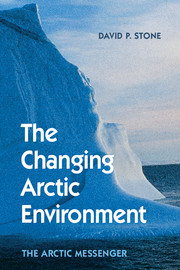Book contents
- Frontmatter
- Dedication
- Contents
- Acknowledgements
- Acronyms
- 1 Personal Beginnings
- PART I THE CHANGING ARCTIC
- PART II WORKING TOGETHER
- PART III WHAT IS THE PRESENT STATE OF KNOWLEDGE?
- PART IV WHAT DOES ALL THIS MEAN?
- 11 Thoughts on Education, the Training of Arctic Scientists, and Arctic Research
- 12 The Long and the Short of It: Has the Arctic Messenger Been Noticed? What Can Be Done?
- 13 Epilogue: Keeping the Rovaniemi Flame Alive
- Appendix I The Intergovernmental Panel on Climate Change (IPCC)
- Appendix II What Will Happen in the Future If We Do Nothing or If We Try Very Hard to Aggressively Reduce GHG Emissions: Projected Change Under Different Emission Scenarios
- Appendix III Some Geophysical Background Notes Related to Climate and Weather
- Appendix IV Orbital Forcing
- Appendix V The Concept of Commitment
- Bibliography
- Credits
- Index
12 - The Long and the Short of It: Has the Arctic Messenger Been Noticed? What Can Be Done?
from PART IV - WHAT DOES ALL THIS MEAN?
Published online by Cambridge University Press: 05 February 2015
- Frontmatter
- Dedication
- Contents
- Acknowledgements
- Acronyms
- 1 Personal Beginnings
- PART I THE CHANGING ARCTIC
- PART II WORKING TOGETHER
- PART III WHAT IS THE PRESENT STATE OF KNOWLEDGE?
- PART IV WHAT DOES ALL THIS MEAN?
- 11 Thoughts on Education, the Training of Arctic Scientists, and Arctic Research
- 12 The Long and the Short of It: Has the Arctic Messenger Been Noticed? What Can Be Done?
- 13 Epilogue: Keeping the Rovaniemi Flame Alive
- Appendix I The Intergovernmental Panel on Climate Change (IPCC)
- Appendix II What Will Happen in the Future If We Do Nothing or If We Try Very Hard to Aggressively Reduce GHG Emissions: Projected Change Under Different Emission Scenarios
- Appendix III Some Geophysical Background Notes Related to Climate and Weather
- Appendix IV Orbital Forcing
- Appendix V The Concept of Commitment
- Bibliography
- Credits
- Index
Summary
Life is a strange thing indeed
-just when you are getting the hang of it,
a gibbet marks the skyline.
Dáithí Ó hÓgáin, “Too Late” from Footsteps From Another WorldWhen it is obvious that your goals cannot be reached, do not
adjust the goals.
Adjust the action steps.
Confucius, The AnalectsEarth scientists use the geological time scale to describe the passage of time in Earth's history. The scale consists of a hierarchy of units, each of which is characterized by a combination of different conditions that prevailed at the time of that unit. In the 1980s, ecologist Eugene F. Stoermer proposed the term “anthropocene” to describe the stage in which we now live. The rationale is that humankind is responsible for major and fundamental long-lasting geophysical changes in the atmosphere and oceans. They are at the same level of magnitude as changes that mark the boundaries between many past geological periods. Our impact on the global ecosystem will be the dominating feature that geologists thousands or millions of years into the future will use to describe the present time. The idea gained momentum with support in 2000 from Dutch Nobel Prize winner Paul Crutzen (who we met earlier in the chapter on stratospheric ozone depletion). This proposed designation is now being examined to see if it should be formally embraced in the geological time scale. A decision is planned for 2016. The idea that the term anthropocene has even been suggested as a geological epoch makes me pause. What are we doing to our planet?
What Drives Societies to Make Decisions That Prove to Be Fatal for the Sustainability of Their Environments?
As I began to work my way through writing this book, I became more and more apprehensive. How would I finish it? It was a task I felt ill equipped to tackle. However, I remembered Jared Diamond's 2005 book Collapse: How Societies Choose to Fail or Succeed.
- Type
- Chapter
- Information
- The Changing Arctic EnvironmentThe Arctic Messenger, pp. 279 - 299Publisher: Cambridge University PressPrint publication year: 2015



